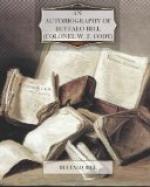After the chase was over I rode over to Major North and asked him about the animal. I was told that he was one of the favorite steeds of the command.
“What chance is there to trade for him?” I asked.
“It is a Government horse,” replied the Major. “The Indian who rides him is very much attached to him.”
I told Major North I had fallen in love with the horse, and asked if he had any objections to my trying to secure him. He replied that he had not. A few days later, after making the Indian several presents, I persuaded him to trade horses with me. In this way I became possessed of the buckskin, although he still remained Government property. I named him Buckskin Joe, and he proved to be a second Brigham.
I rode him during the summers of ’69, ’70, ’71, and ’72. He was the horse ridden by the Grand Duke Alexis on his buffalo hunt. In the winter of ’72, after I had left Fort McPherson, Buckskin Joe was condemned and sold at public sale to Dave Perry at North Platte. In 1877 he presented him to me. He remained on my ranch on the Dismal River for many years, stone blind, until he died.
At the end of twenty days, after a few unimportant running fights, we found ourselves back to the Republican River.
Hitherto the Pawnee scouts had not taken much interest in me. But while at the camp I gained their respect and admiration by showing them how to kill buffaloes. Though they were excellent buffalo killers, for Indians, I had never seen them kill more than four or five animals in one run. A number of them would surround a herd and dash in on it, each one killing from one to four buffaloes. I had gone out in company with Major North, and watched them make a “surround.” Twenty Pawnees, circling a herd, killed thirty-two buffaloes.
As they were cutting up the animals, another herd appeared. The Pawnees were getting ready to surround it, when I asked Major North to keep them back to let me show them what I could do. He did as I requested. I knew Buckskin Joe was a good buffalo horse, and, feeling confident that I would astonish the Indians, I galloped in among the herd. I did astonish them. In less than a half-mile run I dropped thirty-six, killing a buffalo at nearly every shot. The dead animals were strung out over the prairie less than fifty feet apart. This manner of killing greatly pleased the Indians. They called me “Big Chief,” and thereafter I had a high place in their esteem.
We soon left the camp and took a westward course up the Republican River. Major North, with two companies of his Pawnees, and Colonel Royal, with two or three companies of cavalry, made a scout north of the river.
After making camp on the Blacktail Deer Fork we observed a band of Indians coming over the prairie at full gallop, singing and yelling and waving their lances and long poles. We first supposed them to be the hostile Sioux, and for a few moments all was excitement. But the Pawnees, to our surprise, made no effort to go out to attack them. Presently they began singing themselves. Major North walked over to General Carr and said:




